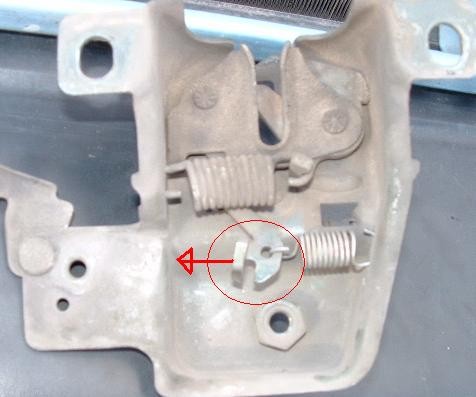A broken Cable Hood Latch can be a frustrating experience, leaving you stranded with a hood that won’t open. This guide provides a simple, effective solution to release a stuck hood latch without damaging your vehicle’s grill. This method, discovered during a junkyard exploration, requires minimal tools and can be performed in minutes.
Understanding the Hood Latch Mechanism
The hood latch is a simple yet crucial component securing your car’s hood. A cable connected to a release lever inside the car controls it. Pulling this lever activates the cable, which in turn disengages the latch, allowing you to open the hood. When this cable breaks, the connection is lost, leaving the hood latched shut.
The image above illustrates the hood latch mechanism from the rear. The circled latch needs to be pushed to the right to release the hood. A spring, typically applying pressure to keep the latch engaged, can be disengaged to simplify the process.
Step-by-Step Guide to Release a Stuck Hood Latch
Disengaging the Spring:
-
Locate the spring connected to the hood latch mechanism. This is often accessible through the front grill.
-
Using a small flat-head screwdriver, carefully pry the spring out of its housing. The spring may spring back into the mechanism; this is acceptable as long as it’s no longer applying pressure to the latch.
Releasing the Latch:
-
Insert the same flat-head screwdriver into the hole where the spring was located. You may need to access this through the grill, potentially requiring assistance to guide the screwdriver from below.
-
Ensure the screwdriver is inserted straight and level, then apply gentle pressure to push the latch mechanism to the right. Having a helper apply slight downward pressure on the hood can assist in releasing the latch. You should hear a distinct “clang” indicating the latch has disengaged.
Alternative Method for Vehicles Without a Plastic Backing
Some older vehicle models may not have a plastic backing on the hood latch mechanism. In these cases, a long box-end wrench may be used to reach up from underneath and engage the latch hook. The box end of the wrench provides the necessary angle for successful engagement.
Preventing Future Cable Hood Latch Issues
Regularly inspecting your hood release cable for signs of fraying or damage can help prevent this situation. Replacing a worn cable is a preventative measure that can save you from the hassle of a broken cable hood latch. Addressing a frayed cable proactively ensures reliable hood operation and avoids potential roadside emergencies. This simple check can prevent a broken cable hood latch. A functioning cable hood latch is critical for routine maintenance and emergency access to your engine compartment.

